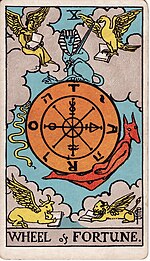
Wheel of Fortune is one of 78 cards in a tarot deck and is the tenth trump or Major Arcana card in most tarot decks. It is used in game playing as well as in divination.

Wheel of Fortune is one of 78 cards in a tarot deck and is the tenth trump or Major Arcana card in most tarot decks. It is used in game playing as well as in divination.
The card pictured is the Wheel Of Fortune card from the Rider–Waite tarot deck. A.E. Waite was a key figure in the development of the tarot in line with the Hermetic magical-religious system which was also being developed at the time, [1] and this deck, as well as being in common use today, also forms the basis for a number of other modern tarot decks. [2]
According to Waite's 1910 book Pictorial Key to the Tarot , the Wheel of Fortune card carries several divinatory associations: [3]
10.WHEEL OF FORTUNE—Destiny, fortune, success, elevation, luck, felicity. Reversed: Increase, abundance, superfluity.
The Wheel Of Fortune card, like other cards of the Major Arcana, varies widely in depiction between tarot decks. The card has been modeled ever since the tarot's inception in the 15th century after the medieval concept of Rota Fortunae , the wheel of the goddess Fortuna. Images generally show a six- or eight-spoked wheel, often attended or crested by an individual (sometimes human; sometimes a Sphinx-like half-human) attired in an Egyptian-style headdress. In some decks, such as the AG Müller, the wheel is also attended by an individual wearing a blindfold; and often there are people sitting or riding on the wheel whilst others are shown falling from it.
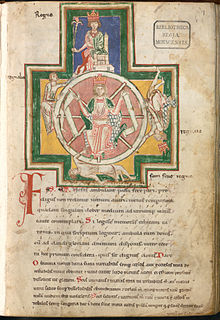
The wheel is not always shown inscribed with any lettering. Where this is the case, the letters T-A-R-O (clockwise) or T-O-R-A (counter clockwise) can often be found aligned against four of the spokes, which can also be interpreted as R-O-T-A, the Latin word meaning "wheel". In some decks, such as the Waite, the wheel is also inscribed with additional alchemical symbols representing the four elements: Earth, Air, Fire and Water (which are also said to be represented throughout the tarot by the four "suits" of Pentacles or Discs, Wands, Swords, and Cups respectively. [4] These emblems can also be seen on the Magician's table in the Magician card [Card I]).
On the Waite card shown, though not necessarily on others, there are also four yellow winged creatures in the corners of the card, representing the symbols of the four Evangelists (The Lion, the Ox, the Man and the Eagle). These four Evangelists are also represented by the four fixed astrological signs: Taurus, Leo, Scorpio and Aquarius. In addition a representation of the god Anubis is seen rising with the wheel on the right side, while the snake-like Typhon descends on the left. On the wheel, alternating with the letters T-A-R-O are the Hebrew letters י-ה-ו-ה, usually transliterated as YHWH (Yahweh - Hebrew for God).
A common aspect to most interpretations of this card within a reading is to introduce an element of change in the querent's life, such change being in station, position or fortune: such as the rich becoming poor, or the poor becoming rich. [5] [6] [7]
In the manga JoJo's Bizarre Adventure Stardust Crusaders , characters' powers (also known as 'Stands') are named after tarot cards. The Wheel of Fortune 'stand' belongs to ZZ, a minor antagonist.
In The House of the Dead, each of its bosses in the mainline series are named after the Major Arcana Tarot Cards (excluding The Devil). The final boss of its third installment is named after The Wheel of Fortune card (now renamed 'Wheel of Fate'), being the resurrected form of the series' main antagonist, Dr. Roy Curien.

The Major Arcana are the named or numbered cards in a cartomantic tarot pack, the name being originally given by occultists to the trump cards of a normal tarot pack used for playing card games. There are usually 22 such cards in a standard 78-card pack, typically numbered from 0 to 21. The name is not used by tarot card game players.

The Rider–Waite Tarot is a widely popular deck for tarot card reading. It is also known as the Waite–Smith, Rider–Waite–Smith, or Rider Tarot. Based on the instructions of academic and mystic A. E. Waite and illustrated by Pamela Colman Smith, both members of the Hermetic Order of the Golden Dawn, the cards were originally published by the Rider Company in 1909. The deck has been published in numerous editions and inspired a wide array of variants and imitations. It is estimated that more than 100 million copies of the deck exist in more than 20 countries.

The Magician (I), also known as The Magus or The Juggler, is the first trump or Major Arcana card in most traditional tarot decks. It is used in game playing and divination; in the English-speaking world, the divination meaning is much better known.

The High Priestess (II) is the second Major Arcana card in cartomantic Tarot decks. It is based on the 2nd trump of Tarot card packs. In the first Tarot pack with inscriptions, the 18th-century woodcut Tarot de Marseilles, this figure is crowned with the Papal tiara and labelled La Papesse, the Popess, a possible reference to the legend of Pope Joan.

The Empress (III) is the third trump or Major Arcana card in traditional tarot decks. It is used in card games as well as divination.

The Hanged Man (XII) is the twelfth Major Arcana card in most traditional tarot decks. It is used in game playing as well as in divination.
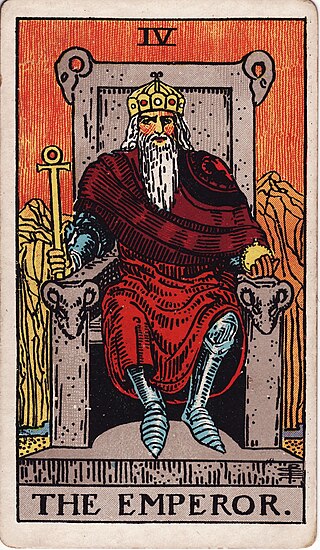
The Emperor (IV) is the fourth trump or Major Arcana card in traditional tarot decks. It is used in game playing as well as in divination.

Strength is a Major Arcana tarot card, and is numbered either XI or VIII, depending on the deck. Historically it was called Fortitude, and in the Thoth Tarot deck it is called Lust. This card is used in game playing as well as in divination.

Justice is a Major Arcana tarot card, numbered either VIII or XI, depending on the deck. This card is used in game playing as well as in divination.
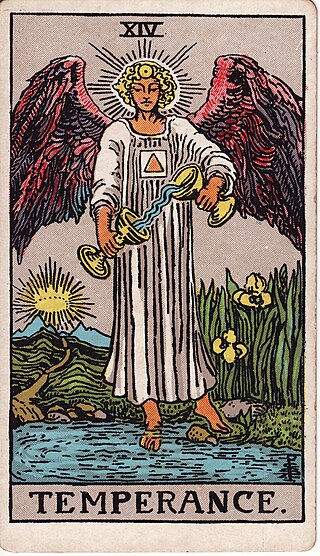
Temperance (XIV) is one of the 22 Major Arcana cards in Tarot decks. It is usually numbered 14. It depicts a figure which represents the virtue Temperance. Along with Justice and Strength, it is one of three Virtues which are given their own cards in traditional tarot. It is used in both game playing and in divination.

The Devil (XV) is the fifteenth trump or Major Arcana card in most traditional tarot decks. It is used in game playing as well as in divination.

The Tower (XVI) (most common modern name) is the 16th trump or Major Arcana card in most Italian-suited tarot decks. It has been used in Tarot cards since the 15th century as well as in divination since the mid-19th century.

The Star (XVII) is the 17th ranking or Major Arcana card in most traditional tarot decks. It is used in game playing as well as in divination.

The Moon (XVIII) is the eighteenth trump or Major Arcana card in most traditional tarot decks. It is used in game playing as well as in divination.

The Sun (XIX) is the nineteenth trump or Major Arcana card in most traditional tarot decks. It is used in game playing as well as in divination.

The World (XXI) is the 21st trump or Major Arcana card in the tarot deck. It can be incorporated as the final card of the Major Arcana or tarot trump sequence (the first or last optioned as being "The Fool" (0). It is associated with the 22nd letter of the Hebrew alphabet, 'Tau', also spelled 'Tav' or 'Taw'.
The BOTA Tarot was created by Paul Foster Case, founder of Builders of the Adytum (BOTA), and artist Jessie Burns Parke. Although it is based upon, and closely resembles, Arthur Edward Waite's 1909 Rider-Waite deck, Case changed what he said were mistakes or "blinds" on the part of Waite. The BOTA Tarot is available as a standard-sized deck and a larger version containing only the Major Arcana in black and white, as Case believed that every student must color in their own deck. After his death, the Major Arcana became also available in color. Each of these cards has a border of a particular color associated with that according to Case. The Minor Arcana cards are illustrated with suit symbols only.
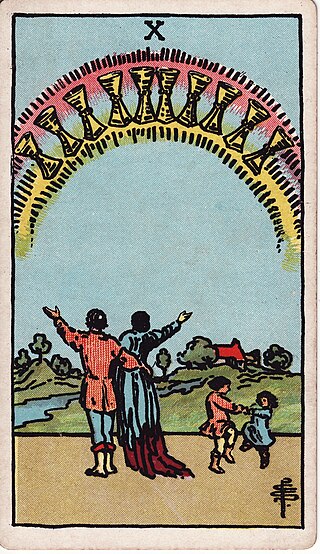
The Ten of Cups is a Minor Arcana tarot card.

Tarot card reading is a form of cartomancy whereby practitioners use tarot cards to purportedly gain insight into the past, present or future. They formulate a question, then draw cards to interpret them for this end. A traditional tarot deck consists of 78 cards, which can be split into two groups, the Major Arcana and Minor Arcana. French-suited playing cards can also be used; as can any card system with suits assigned to identifiable elements.

The Fool is one of the 78 cards in a tarot deck. In tarot card reading, it is one of the 22 Major Arcana, sometimes numbered as 0 or XXII. However, in decks designed for playing traditional tarot card games, it is typically unnumbered, as it is not one of the 21 trump cards and instead serves a unique purpose by itself.
{{cite book}}: CS1 maint: multiple names: authors list (link) CS1 maint: numeric names: authors list (link)